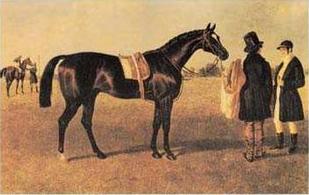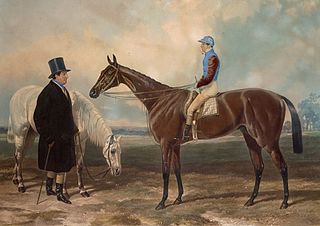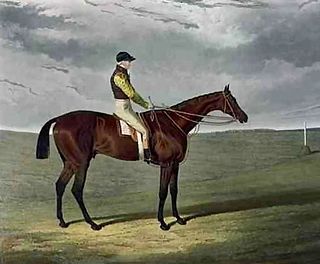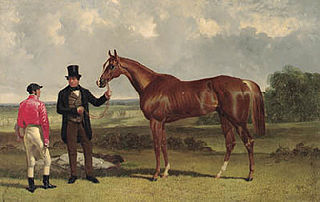
Francis Buckle (1766–1832), known to the British horse racing public as "The Governor", was an English jockey, who has been described as "the jockey non-pareil" of the opening quarter of the 19th century, and the man who "brought respectability to race-riding". He won at least 27 British Classic Races during his career, a record which would not be beaten for over 150 years.

Elnathan "Nat" Flatman, born Holton St. Mary, Suffolk, was the first Champion flat racing jockey of Great Britain. He began his thirty-four-year racing career as an apprentice jockey at age fifteen and by 1840 he was the dominant rider in British racing, winning the Champion Jockey title thirteen years in a row. During his career, Flatman won the patronage of many significant owners, including Lord George Bentinck, the Earl of Chesterfield, Admiral Rous, Lord Stradbroke and Lord Derby. For these owners, and others like them he won most of the important Thoroughbred horse races in England, including ten Classics, and some significant races in France. He continued to ride until the paddock accident that incapacitated him and ultimately led to his death at the age of 50.
John Scott (1794–1871) was a leading horse trainer in British Thoroughbred racing during the 19th century. Known as "The Wizard of the North", he was a brother to the successful jockey Bill Scott.

Touchstone (1831–1861) was a British bred Thoroughbred racehorse and a leading sire in Great Britain and Ireland on four occasions. He was owned and bred by Robert Grosvenor, 1st Marquess of Westminster, who bought him for the low price, at the time, of 600 guineas at the insistence of his chief stud groom Mr. Thomas Nutting.

Surplice (1845–1871) was a British Thoroughbred racehorse and sire. In a career that lasted from July 1847 to October 1849 he ran thirteen times and won nine races. He was the leading colt of his generation in England at both two and three years old, with his wins including The Derby and the St Leger in 1848: he was the first horse for forty-eight years to win both of these Classics. His later career was less successful and he was retired to stud in 1850. Surplice had limited success as a sire of winners and died in 1871.

Cossack also known as "The Cossack", was a British Thoroughbred racehorse and sire. In a career that lasted from July 1846 to June 1849 he ran twenty-two times and won three races. In 1847 he proved himself one of the best British colts of his generation, winning Derby and being narrowly beaten in the St Leger. Although he continued to run well in important staying races for the next five seasons, he failed to win another race and was retired to stud in after running once as an eight-year-old in 1852. No subsequent winner of the Epsom Derby has run beyond the age of five. He was later exported to stand as a stallion in France.

Sir Tatton Sykes (1843–1860), who also raced under the name Tibthorpe, was a British Thoroughbred racehorse and sire. In a career that lasted from spring 1846 to summer 1848 he ran eleven times and won four races. As a three-year-old in 1846 he won two of the three races which became known as the Triple Crown, taking the 2000 Guineas at Newmarket and the St Leger at Doncaster. He was considered by some to have been unlucky when he was narrowly defeated in The Derby. The rest of his career was a disappointment as he won only one race in the next two seasons. After being retired to stud he had some success as a sire of winners.

William Clift (1762–1840), born Wentworth, South Yorkshire, was a British jockey. He won the first runnings of both the 1,000 Guineas and 2,000 Guineas and was the first jockey to win all five of the British Classics.

Newminster was a British Thoroughbred racehorse who won the St. Leger Stakes in 1851. He raced for four seasons, winning two of his ten races. He retired to stud in Yorkshire and became British champion sire in 1859 and 1863. Newminster sired the Derby winners Musjid and Hermit and the champion sires Adventurer and Lord Clifden. He was trained by John Scott and owned by Anthony Nichol throughout his racing career.
Edward William George Hide was a British multiple classic winning jockey. He was, at his peak, the sixth most successful jockey in British racing history and remained the ninth most successful jockey over 30 years after his retirement.
Ernest Johnson is an Epsom Derby winning British flat racing jockey.

Thomas Goodisson (1782–1840) was a four times Epsom Derby winning British jockey. He was the son of Dick Goodisson, the jockey who won the first three runnings of The Oaks.
John Shepherd was a four times British Classic-winning jockey and trainer. He was a pioneering Northern jockey, one of the few of his time to move south to Newmarket, the home of British horse racing and gain a reputation there.

John Forth was a British jockey and racehorse trainer. He is the oldest man to have ridden the Derby winner and one of the very few to have both ridden and trained the winner.
Lambert Simnel (1938–1952) was a British Thoroughbred racehorse and sire, who raced during World War II and was best known for winning the classic 2000 Guineas in 1941. As a two-year-old he won once and finished second in the Dewhurst Stakes In the following spring he won the 2000 Guineas, beating a field which included the subsequent classic winners Owen Tudor and Sun Castle. He was beaten when favourite for the Derby and finished unplaced in the St Leger. He won once as a four-year-old in 1942 before being retired to stud. He stood as a breeding stallion in England and Argentina with limited success before his death in 1952.

Job Marson (1817–1857) was an English classic-winning jockey, whose most famous partnership was with Voltigeur, winner of the 1850 Derby and St Leger.

Alfred Day was a British classic winning jockey. He won seven classics between 1849 and 1859, including the Derby on Andover, and was nicknamed "King Alfred" for his success.

Ralph "Geordie" Bullock was a Derby-winning British jockey.

William Raphael "Rae" Johnstone, was an Australian flat-race jockey. After enjoying considerable success in his native country, he relocated to Europe in 1932 and spent most of the rest of his life in France. He won twelve British Classic Races and two Prix de l'Arc de Triomphes. On his retirement in 1957 he was described as "one of the greatest international jockeys of modern times". He died of a heart attack in 1964.
Edwin Piper was a British flat racing jockey, who won the 1913 Epsom Derby, also known as the "Suffragette Derby" due to the death of suffragette Emily Davison during the race, on Aboyeur.















